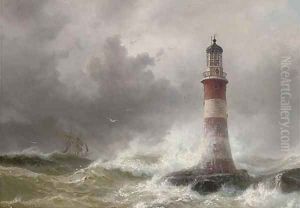Wilhelm Melbye Paintings
Wilhelm Melbye, also known as Vilhelm Melbye, was a Danish marine artist, born on February 14, 1824, in Elsinore, Denmark. He was the younger brother of Anton Melbye and Fritz Melbye, both of whom were also accomplished artists. Coming from a family with a strong artistic tradition, Wilhelm was particularly influenced by his older brother Anton, who was well-regarded for his own marine paintings.
Wilhelm Melbye's artistic journey began under the mentorship of his brother and he later continued his education at the Royal Danish Academy of Fine Arts. His early career was marked by travels throughout Europe, which was a common practice for artists of the time seeking to gain exposure to different scenes and artistic methods. These travels provided Melbye with a rich source of inspiration and allowed him to study under various masters, further refining his technique.
Melbye specialized in marine art, capturing the dynamic and often tumultuous relationship between the sea and ships. His works are known for their meticulous detail and atmospheric quality, often highlighting the drama of seascapes under varied weather conditions. Throughout his career, he exhibited his works in Denmark and across Europe, gaining recognition for his contributions to the genre of marine painting.
In the 1850s, Melbye settled in Paris, which was then a hub for artists from around the world. He became associated with the Barbizon school — a group of artists who moved away from the formal traditions of the French Academy to embrace a more naturalistic and plein-air approach to landscape painting. Although primarily a marine artist, Melbye's work during this period showed an affinity with the Barbizon school's emphasis on the natural environment.
Wilhelm Melbye's oeuvre includes a variety of seascapes, from calm coastal scenes to dramatic shipwrecks and naval battles. His ability to convey the movement and power of the sea made him a popular artist during his lifetime. His works can be found in various museum collections and continue to be sought after by collectors of marine art.
Melbye's career spanned several decades, and he continued to paint until his death on October 10, 1882, in Roskilde, Denmark. His legacy lives on through his evocative seascapes, which capture the timeless majesty and peril of the sea.
